History
ESTABLISHMENT OF PCS
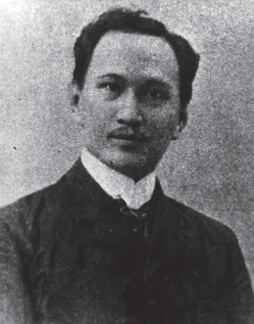
Dr. Gregorio T. Singian
When the PCS was established on September 12, 1936, it was a mere 10 months since the inauguration of the Commonwealth. This was the political framework that served as a context to the formation of the PCS. The Commonwealth was the period meant to prepare for the upcoming “grant of independence” by the USA, declared 10 years later in 1946. At his inauguration, Commonwealth President Manuel L. Quezon spoke in a booming voice before a crowd of a quarter million Filipinos assembled at the sunken garden fronting the Legislative building. President Quezon pleaded for cooperation as he was still answerable to a higher power, the USA. The Commonwealth period, according to Quezon, should serve as a challenge for Filipinos to gain respectability. The Filipinos had to demonstrate their abilities and moral high ground. The surgeons who would have founded the PCS answered the call of President Quezon. The PCS developed institutionally what they gained through experience with the Colegio Medico. The practices of European medical education, such as the concept of preceptorship (tutorship), were promoted within their ranks. However, being born during the American regime, the PCS could not avoid adopting the more structured, researchbased and collective system of surgery that was becoming the new modality of training. Still, it did not abandon the concept of preceptorship as it was slowly moving toward the establishment of standards with definite curricula and examinations as advocated by the American Board of Surgery.
WHO WERE THE CHAPTER FELLOW OF THE PCS?
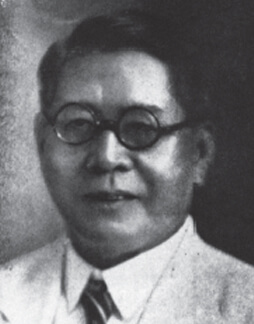
Dr. Baldomero Roxas
According to the PCS by-laws, the members at the time of its founding would be called Charter Fellows aside from being called Fellows. In its Art. X, Section 3, “a member who shall hereafter have been in good standing with the College for five consecutive years shall be designated a Fellow of the Philippine College of Surgeons and be entitled to affix the letters “FPCS” to his name on professional cards, directories and publications. Until such time he may use the letters “MPCS” ”. In other words, there were Fellows and there were Members, the latter being those who had not yet attained the number of years and the years of sufficient experience that went with the title of being a Fellow. Patrons and Honorary Fellowship could also be given to recognized personalities upon a vote of threefourths of all Fellows during the Annual Meeting. The Committee on Credentials received the nominations three months before the election. As for the others, membership could be gained through an application and the submission of various requirements. To qualify as a member, the first requirement was a certification on rotating internship in a general hospital for two years after graduating with an MD degree. An applicant should also have a residency or assistantship in a surgical specialty in an institution of recognized standing, or a tutorship with a specialist of standing.
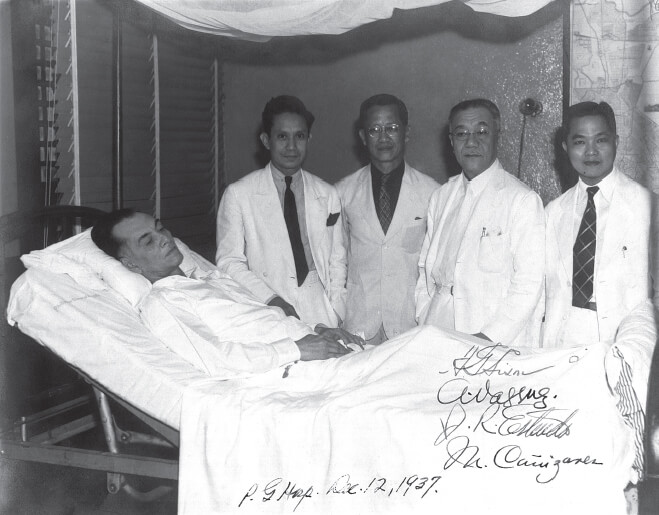
Dr. Januario Estrada (rightmost) with Pres. Quezon after the president’s appendectomy at the PGH in 1937, with Dr. Antonio Vasquez (second from right), a surgeon from the UP, also a personal physician of the president, and Dr. Miguel Canizares (leftmost).
As proof of his or her expertise, the applicant should be able to submit complete records of at least 50 consecutive major operations that he (or she) performed himself (or herself ) or in which he (or she) served as first assistant. Aside from the payment of initiation dues, the candidate should be able to show evidence of a high ethical and professional standing acceptable to the Board. Unethical conduct, after due investigation by the Board Of Regents could lead to censure, suspension, or expulsion. The reputation of its founders would serve as a source of strength for the PCS. Dr. Singian’s reputation as a man of empathy for others, and one with boundless energy and hunger for the perfection of his craft were recognized by his peers and biographers alike. Because of his intimate understanding that the field of medical operation was so complex that it required various specialists working together, Dr. Singian proposed the formation of a Philippine College of Surgeons. Joining Dr. Singian as Vice-President was Dr. Baldomero L. Roxas, a classmate of Jose Rizal at the UST and in Spain where Roxas both finished his medical education.
(Together with Rizal, Roxas formed the group “Los Indios Bravos” after visiting the 1889 Paris Exposition and witnessing how American Indians gathered plaudits from the crowd for their skill in horseback riding and archery. As the term “ Indio” was used derogatorily by the Spaniards when referring to their colonial subjects, the Filipino expatriates in Paris transformed it from being a negative to a term of high regard in the manner of the Brave Indians in Buffalo Bills stories.) Like Dr. Singian, Dr. Roxas also served in the Medical Corps of the Philippine Republic during its War of Independence with Spain and the US in 1899. Dr. Valentine Afable established the Afable College of Medicine and Surgery that became the beginnings of the Manila Central University Hospital. Dr. Januario Y. Estrada Sr., together with some friends, established the Surgery Department at the Manila Doctor’s Hospital. Dr. Estrada was also the personal physician of Pres. Manuel L. Quezon, accompanying him in trips.
THE B.O.R. AND MEMBERSHIP
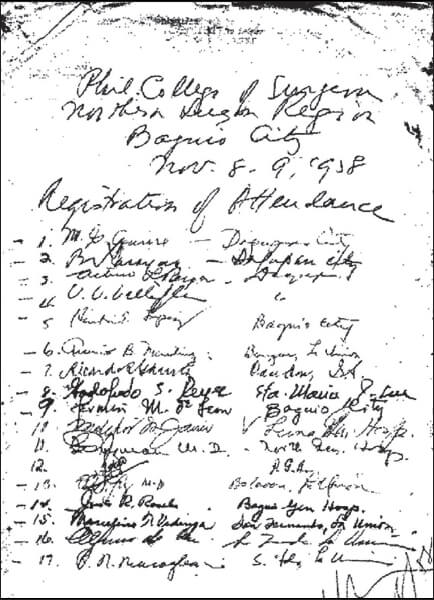
Attendance Sheet for the Northern Luzon Chapter, November 1958
While PCS tried to consolidate its membership, its programs remained tentative. This reality is especially important to note in the light of the creation of other organizations similar in purpose to that of the PCS. In 1954, the Philippine College of Physicians was established. With this development, institutional boundaries of the two groups had to be established to prevent collision in turf and strategic concerns. As we learn later, the definition between Surgeons and Physicians were not well understood yet by the public. The institutional boundaries had yet to be defined through legislation, which indeed had been suggested with the passage of a Medical Act in 1949. Unfortunately, while the Medical Act recognized that surgery required a higher level of academic training and preparation, nothing had been stated categorically on how it should be practiced. The issue of certification or qualification was never defined. Hence, except for those in the field of Ophthalmology and Obstetrics-Gynecology—both of which had established a Board that qualified the practitioners in their field—there were no self-regulatory mechanisms put in place. In the public mind, a doctor could be both a surgeon and a physician at the same time. As for the PCS, the main institutional concern was to keep surgical standards high. Thus, to differentiate themselves from the other doctors, the PCS had institutionalized a Fellowship System, which had been a body stipulated in the original By-laws, but not seriously implemented. In contrast to Fellows, the original members would now be called Founders or Charter Fellows. To be called a Fellow, one had to pay an initiation fee of P100 and P25 per year paid on January 1 for at least five years. After five years of active membership, one may be called a Fellow and be allowed to put the initials “FPCS” after one’s name. In the period that one was not yet a Fellow, one could put in his business card the title “MPCS”, which stood for “Member of PCS.“ Originally, there were only seven Regents consisting of a President, a Vice-President, a Secretary-Treasurer and four Regents, all of whom had three year-terms. The BOR’s role was to “consider all questions involving the rights and standing of members especially unethical and disciplinary (in nature).” There were initiatives undertaken toward the creation of chapters to make the College an institution with a national scope. However, there was no clear explanation of how the chapters would function in relation to the central office. If the vision was really to upgrade post-graduate training, it was doubtful if such chapters had the access to hospitals with sufficient equipment and facilities to conduct training, internship or residency programs. Another major problem was how to come up with a team of trainers and lecturers willing to go and teach in the regions. Furthermore, provincial hospitals still lacked the facilities for post-graduate training in surgery. Thus, there existed the paradox of the PCS wanting to upgrade surgery but the provinces not having the fundamental facilities to implement training programs.
HOW PCS AQUIRED ITS LOT
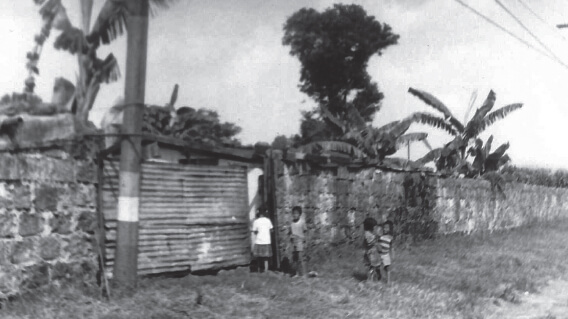
The lot along Highway 54 which eventually became the site of the present PCS Building.
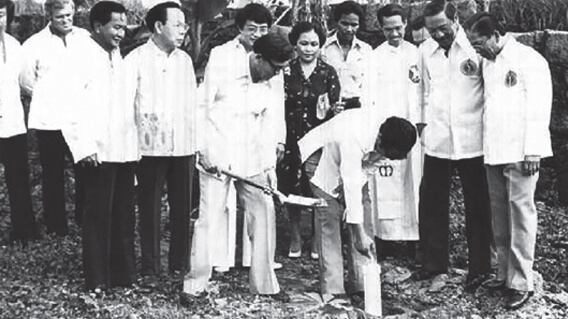
Cornerstone Laying on June 13, 1980
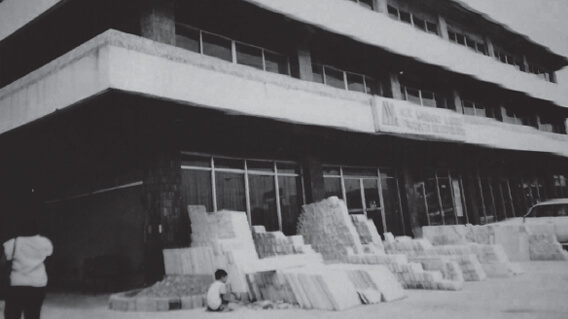
The second and third floors of the PCS Building are completed.
The Philippine Homesites and Housing Corporation (now called National Housing Authority), the government agency mandated to provide housing on easy terms, had provision for institutional buildings such as hospitals, churches and schools. Amidst this area traversed by the still new Avenida de 19 de Junio [renamed Highway 54, then EDSA], the PCS purchased a lot in the section reserved for institutional development. It was a good piece of property, near the projected park bounded by the North Avenue and East Avenue, the roads leading to the Quezon Memorial Circle. The PCS lot was also not very far from the one allotted to the Philippine Medical Association where the PMA wanted to construct a dorm for doctors from the provinces visiting Manila and an auditorium that would also serve as its offices. The purchase of the lot for the PCS headquarters was made through the initiative of then Congressman from Ilocos Sur, Dr. Godofredo Reyes, who was likewise a Fellow of the PCS. He negotiated with the PHHC for the purchase of the 1,344 sq. meters lot on easy terms. A collateral benefit of his negotiation was the discovery that the PCS had to renew its registration at the Securities and Exchange Commission, a requirement by the PHHC. The BOR, under the leadership of Dr. Luis F. Torres (PCS President 1961- 1962), initiated the move to make the PCS an association with a legal personality. The PCS gave its first payment for the property, amounting to PhP100,000 in November 1969. While the site was not yet serviceable, the PCS continued to locate its secretariat in the PGH, and in 1976 a unit was bought from the State Condominium IV in Greenhills along Ortigas Avenue, where a small function room was provisionally provided for group meetings of the Board of Regents, the Governors, or the standing committees.
A PERMANENT HEADQUARTERS AT EDSA, 1985
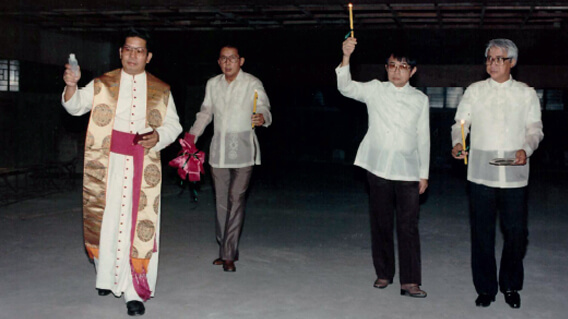
Blessing of the first floor with Fr. Nico Bautista
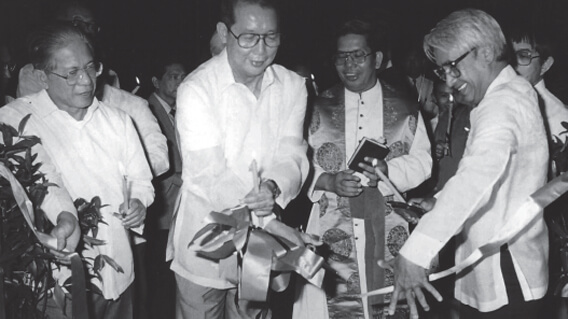
Ribbon cutting during the opening of the PCS building with Dr. Vicente Arguelles
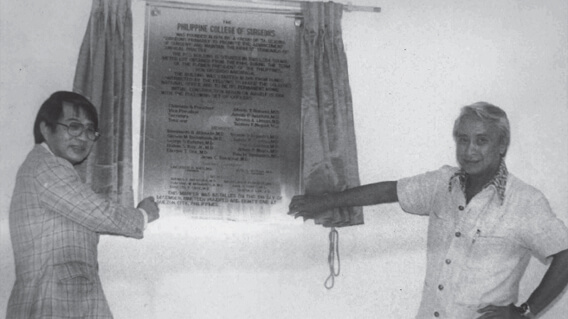
Dr. Teodoro Nuguid and Dr. Antonio Limson with the PCS Building marker, 1981
scheme were followed and complied with. Witnesses to the contract signing included the Chairman of the PCS Building Committee, concurrently Chairman of the Board of PCS Foundation and PCS Treasurer, Dr. Teodoro P. Nuguid and the other members of the Building Committee: Doctors Raul G. Fores, Ponciano M. Bernardo, Jr., Avenilo P. Aventura, Bienvenido B. Aldanese, Ernesto P. Cruz, Gloria D. Lim and Jose G. Geotina. The ground breaking at the PCS lot was held on August 15, 1981. Towards the last leg of construction, the project strained the PCS funds and budget. For one, it incurred a total debt of P255,000 loan from Dr. Teodoro Nuguid and other fellows. At about this time, Henry Sy of Shoemart proposed to build a 3 storey building in exchange for PCS moving to a site 250 meters away from the present site. Doctors Arguelles, Aldanese and Bustamante were tasked to submit their reaction by November 26, 1982. In spite of the offer which could have solved the financial woes of the PCS, the negotiation seemed to have fizzled out as nothing had been mentioned on this matter in any of the official reports of the presidents. On August 31, 1984, with Dr. George Eufemio as president, construction of the second and third floors of the building was completed. In his address during the Annual Convention that December at the Manila Garden, Dr. Eufemio invited members to see the building whose second and third floors had been finished. But the financial report also indicated a serious problem of the organization. PCS Treasurer Dr. Leonardo A. Ona, reported the very low cash position of the College. While some income was expected towards the end of the year, the payables included the interest for loans incurred from PCS members. In July 1985, the sign of the PCS building was installed. On December 4, 1985, with little fanfare, the PCS building was blessed in a ceremony with Fr. Nicanor “Nico” Bautista officiating, a day before the opening of the Annual Convention. It was 15 years from the time that the PCS purchased the lot, made the plans and put the cornerstone. Propitious it was because they were at the onset of the College’s golden anniversary celebration the following year. The following day, December 5, 1985, President Vicente Arguelles addressed the Fellows during the Annual Convention: “We had the formal blessing yesterday, December 4. I urge you all of our fellows to visit our building and secretariat. It is just a stone’s throw away from the big Shoemart building complex at the West Avenue Circle along EDSA, Quezon City. It is now easier to find because [we have placed] a big sign in its façade with our logo and bold letters of stainless steel, THE PHILIPPINE COLLEGE OF SURGEONS.”
From the happy announcement of President Dr. Arguelles, it would look that building the permanent headquarters of the PCS had been as easy as a walk in the park. From the time of conception to its reality, a total of 15 years, it seemed like each PCS president had put one brick upon another brick painstakingly. It took that long and it was not easy. Here are the facts and figures: 1. Construction started August 16, 1981 2. Officially finished on August 31, 1984 3. Total cost: P3,029,012. 33 4. Funds came from loans from members, assessment fees, contributions, fund-raising activities, savings from previous years 5. Total floor area: first floor, 480 sq. m.; second floor, 483 sq. m.; third floor, 483 sq. m. After a period of uncertainty regarding the financial position of the College, the coffers had stabilized. More than a thousand surgeons were inducted as fellows of the College. The PCS had become a more solid institution indicated not only by a new building but by a corporate seal, a hymn and a clear vision as what it wanted to be. The organic committees were established and the Singian annual lectures launched. In 1994, the construction of the building extension started.

